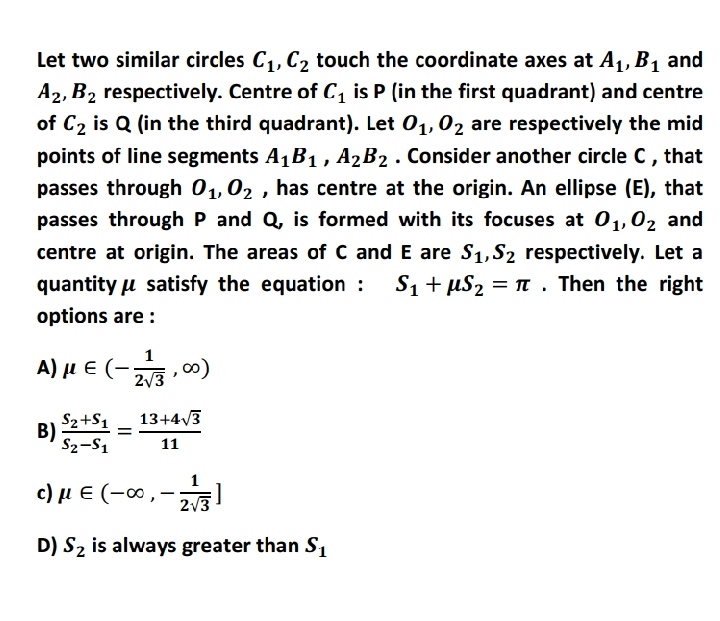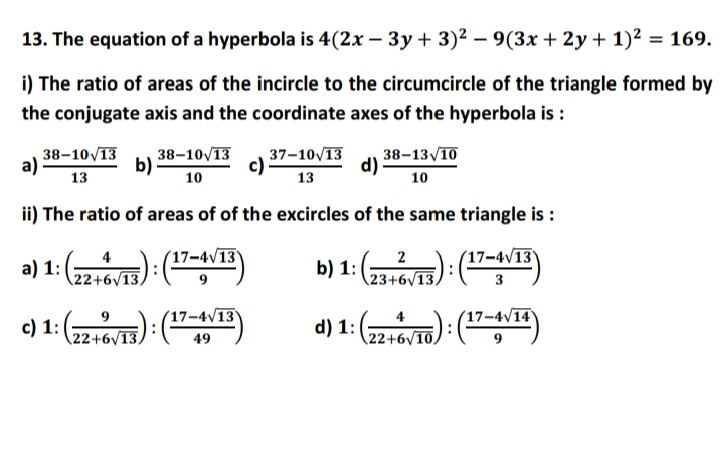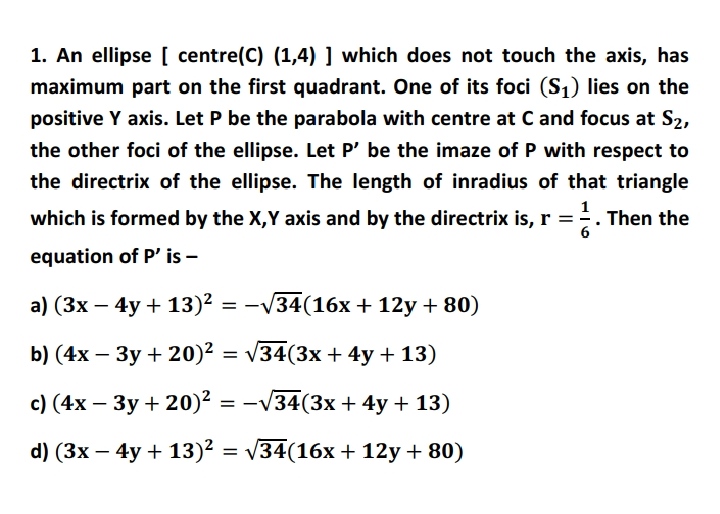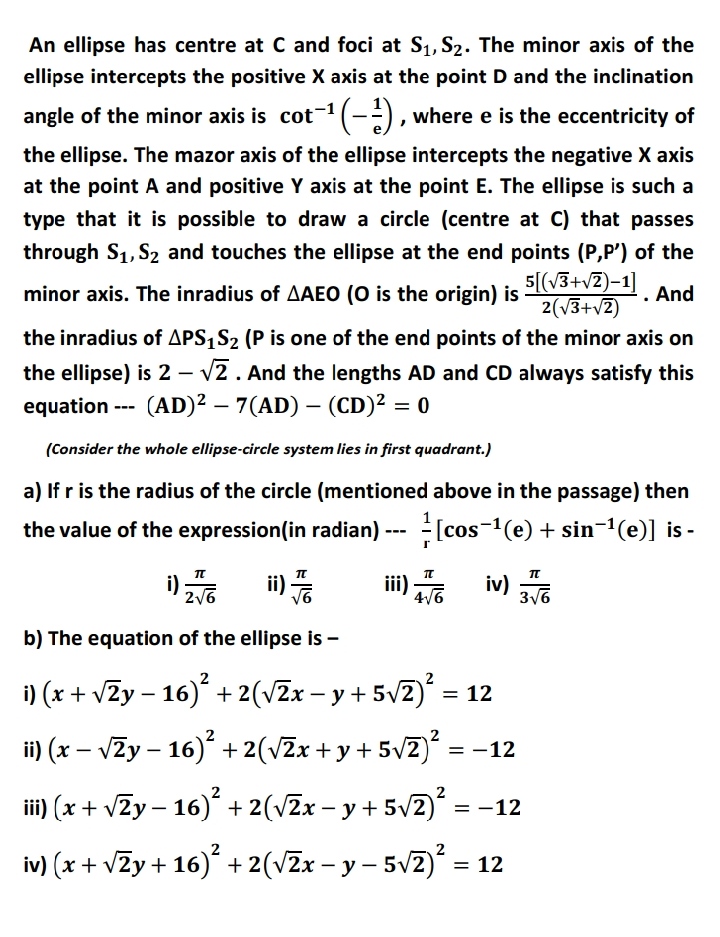7 - Conics Questions Answers
Tips about circle
Circle - Important Definitions
Pole and Polar:
Polar of a point with respect to a circle: through a point P(x1,y1) (inside or outside a circle) there be drawn any straight line to meet the given circle a Q and R, the locus of the point of intersection of the tangents at Q and R is called the polar of point P and P is the called the pole of the polar.
Diameter – definition as a locus: the locus of the middle points of a system of parallel chords of a circle is called a diameter of the circle.
Common chord of two circles: The chord joining the points of intersection of two given circles is called their common chord.
Angle of intersection of two curves: If the two curves C1 and C2 intersect at a point P and PT1 and PT2 be the tangents to the two curves C1 and C2 respectively at P. Then the angle between the tangents at P is called the angle of intersection of the two curves at the point of intersection.
Orthogonal curves: Two curves are said to intersect orthogonally when the two tangents at the common point are at right angles.
Radical axis: the radical axis of two circles is the locus of a point which moves in such a way that the lengths of the tangents drawn from it to the two circles are equal.
Radical centre: The point of concurrence of the radical axes of three circles whose centres are non-collinear, taken in pairs, is called the radical centre of the circles.
Coaxial system of circles: A system of circles, every pair of which has the same radical axis is called a coaxial system of circles.
(x-h)²+(y-k)² = h²+k²
(ii)Circle touches the x axis
C(h,k) centre, a = radius
To satisfy a = k
So equation is
(x-h)²+(y-a)² = a²
(iii)Circle touches the y axis
C(h,k) centre, a = radius
To satisfy a = h
So equation is
(x-a)²+(y-k)² = a²
(iv) When the circle touches both axes
then h = k = a
(x-a)²+(y-a)² = a²
(v) When the circle passes through the origin and centre is on x-axis.
C(h,k) centre, a = radius
As centre is on x axis y coordinate is zero. So k = 0.
As circle is passing through origin a = h
(x-a)²+ y² = a²
(vi) When the circle passes through the origin and centre is on y-axis.
C(h,k) centre, a = radius
As centre is on y axis x coordinate is zero. So h = 0.
As circle is passing through origin a = k
x²+(y-a)² = a²
Centre of this circle = (-g,-f)
Radius = √(g²+f²-c)
then the equation of the circle is
(x - x1)(x - x2)+(y - y1)(y- y2) = 0
Intercepts for the circle x²+y²+2gx+2fy+c = 0
length of intercept on x- axis = 2√(g²-c)(You get it by putting y = 0)
length of intercept on y- axis = 2√(f²-c)(You get it by putting x = 0)
If the point is P find distance between the centre of the circle C and point P.
If the radius of the circle be R
CP is greater than R implies point is outside the circle.
CP = R implies point is on the circle
CP is less than R implies point is inside.
x = r cos θ, y = r sin θ
Parametric equations of (x-a)² + (y-b)² = r²
x = a + r cos θ, y = b + r sin θ
Equation of the line: y = mx+c
A line does not intersect a circle if the length of the perpendicular to the line from the centre of the circle is greater than the radius of the circle.
|c/√(1+m²)|>a
A line intersects a circle if the length of the perpendicular to the line from the centre of the circle is less than the radius of the circle.
|c/√(1+m²)|<a
A line touches a circle if the length of the perpendicular to the line from the centre of the circle is equal to the radius of the circle.
|c/√(1+m²)| = a
Equation of the line: y = mx+c
A line intersects a circle if the length of the perpendicular to the line from the centre of the circle is less than the radius of the circle.
If it intercepts, the length of the intercept is
2√([[a²(1+m²)-c²]/(1+m²) ]
Tangent to a circle at a given point
The line y = mx+c is tangent to a circle x² + y² = a² if the length of the intercept is zero.
That means 2√([[a²(1+m²)-c²]/(1+m²) ] = 0
=> a²(1+m²)-c² = 0
=> c = ±a√(1+m²)
Slope form:
The equation of a tangent of slope m to the circle x² + y² = a² is
Y = mx±a√(1+m²) (Value of c from tangent condition).
The coordinate of the point of contact are (±am/√(1+m²), ±a/√(1+m²)
Point form:
The equation of a tangent at the point (x1,y1) to the circle x² + y²+2gx+2fy+c = 0 is
xx1 + yy1 +g(x+x1)+f(y+y1) +c = 0
Two tangents can be drawn.
The tangent will be of the form y = mx+a√(1+m²)
And the two values of m for the pair is to be found by solving the quadratic equation
m²(x1²-a²) -2mx1y1 +(y1²-a²) = 0
(x² + y²+2gx+2fy+c) (x1² + y1²+2gx1+2fy1+c) = (xx1 + yy1 +g(x+x1)+f(y+y1) +c) ²
Expressed as SS’ = T²
Equation of director circle of the circle x² + y² = a² is x² + y² = 2a²
Polar is the locus of point and pole is a point with respect to which polar is determined.
Equation to the polar of the point (x1,y1) w.r.t. to the circle x² + y² = a² is
xx1+yy1= a²
The polar of the point (x1,y1) w.r.t. to the circle x² + y²+2gx+2fy+c = 0 is given by
(xx1+ yy1 +g(x+x1)+f(y+y1) +c) = 0
The equation is same as the equation for the tangent to the circle at a point (x1,y1) on the circle.
T = S’
(xx1 + yy1+g(x+x1)+f(y+y1) +c) = x1² + y1²+2gx1+2fy1+c
The radius of the largest circle, which passes through the focus of the parabola y2=4(x+y) and contained in it is ???
given equation can be written as (y-2)2= 4(x+1) so coordinate of focus (a, 0) will be x+1 = 1 and y - 2 = 0 so x = 0 and y = 2
let the centre of largest circle inside parabola is (k, 2) so equation of that circle will be (x-k)2 + (y-2)2 = k2
on solving parabola and circle we get x2 + (4-2k) x + 4 = 0
for largest circle roots of this quadratic equation should be equal so b2= 4ac
solve and get k = 4 so radius will be 4

 Consider a branch of the hyperbola x²-2y²-2√2x-4√2y-6=0, with vertex at the point A. Let B be one of the end points of its latus rectum .If C is the focus of the hyperbola nearest to the point A, then the area of the triangle ABC is ??????
Consider a branch of the hyperbola x²-2y²-2√2x-4√2y-6=0, with vertex at the point A. Let B be one of the end points of its latus rectum .If C is the focus of the hyperbola nearest to the point A, then the area of the triangle ABC is ??????
x²-2y²-2√2x-4√2y-6=0
Arrange this equation in form of standard hyperbola as
(x-√2)2/4 - (y+√2)2/2 = 1
so X = x-√2, Y = y+√2
vertex coordinate : X = 0 and Y = 0 so x = √2, y = -√2
similarly focus : X = ae, Y = 0, here a = 2, b = √2 and b2 = a2(1-e2)
and end point of latus rectum : X = ae, Y = b2/a
solve the area and get the answer




